CHEVROLET EXPRESS CARGO VAN 2008 1.G Service Manual
Manufacturer: CHEVROLET, Model Year: 2008, Model line: EXPRESS CARGO VAN, Model: CHEVROLET EXPRESS CARGO VAN 2008 1.GPages: 414, PDF Size: 2.34 MB
Page 41 of 414
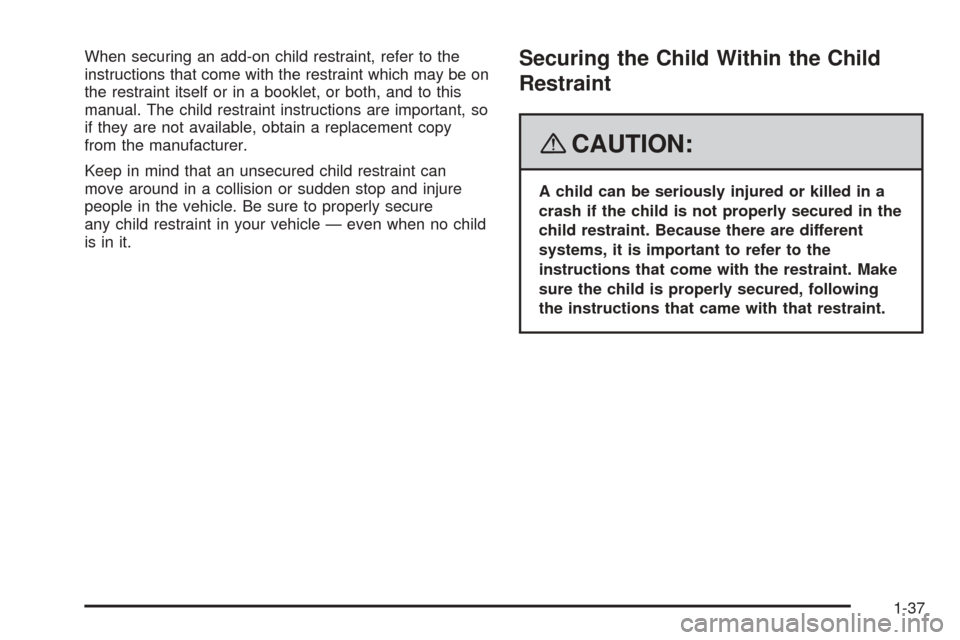
When securing an add-on child restraint, refer to the
instructions that come with the restraint which may be on
the restraint itself or in a booklet, or both, and to this
manual. The child restraint instructions are important, so
if they are not available, obtain a replacement copy
from the manufacturer.
Keep in mind that an unsecured child restraint can
move around in a collision or sudden stop and injure
people in the vehicle. Be sure to properly secure
any child restraint in your vehicle — even when no child
is in it.Securing the Child Within the Child
Restraint
{CAUTION:
A child can be seriously injured or killed in a
crash if the child is not properly secured in the
child restraint. Because there are different
systems, it is important to refer to the
instructions that come with the restraint. Make
sure the child is properly secured, following
the instructions that came with that restraint.
1-37
Page 42 of 414
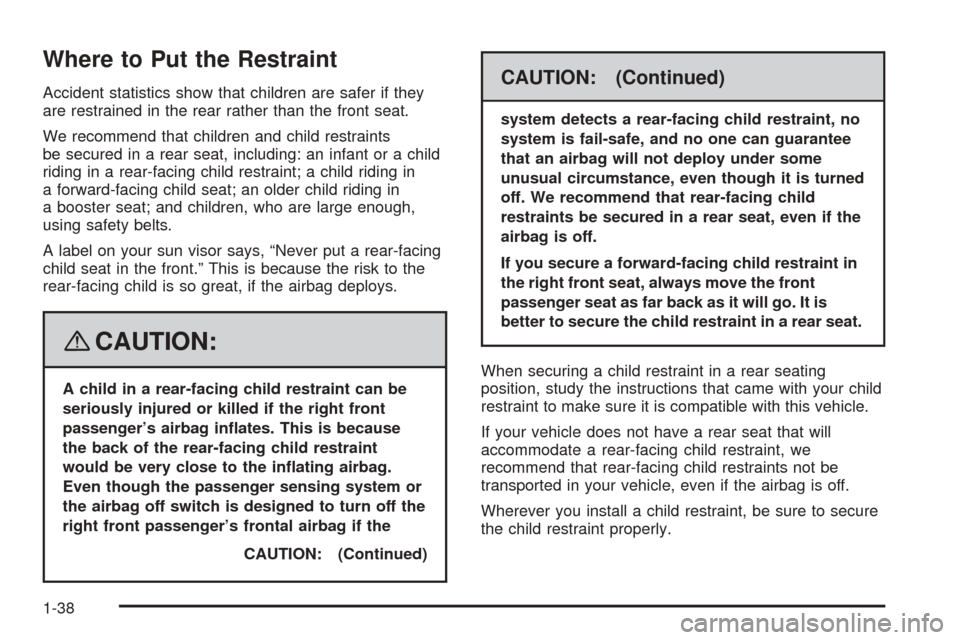
Where to Put the Restraint
Accident statistics show that children are safer if they
are restrained in the rear rather than the front seat.
We recommend that children and child restraints
be secured in a rear seat, including: an infant or a child
riding in a rear-facing child restraint; a child riding in
a forward-facing child seat; an older child riding in
a booster seat; and children, who are large enough,
using safety belts.
A label on your sun visor says, “Never put a rear-facing
child seat in the front.” This is because the risk to the
rear-facing child is so great, if the airbag deploys.
{CAUTION:
A child in a rear-facing child restraint can be
seriously injured or killed if the right front
passenger’s airbag in�ates. This is because
the back of the rear-facing child restraint
would be very close to the in�ating airbag.
Even though the passenger sensing system or
the airbag off switch is designed to turn off the
right front passenger’s frontal airbag if the
CAUTION: (Continued)
CAUTION: (Continued)
system detects a rear-facing child restraint, no
system is fail-safe, and no one can guarantee
that an airbag will not deploy under some
unusual circumstance, even though it is turned
off. We recommend that rear-facing child
restraints be secured in a rear seat, even if the
airbag is off.
If you secure a forward-facing child restraint in
the right front seat, always move the front
passenger seat as far back as it will go. It is
better to secure the child restraint in a rear seat.
When securing a child restraint in a rear seating
position, study the instructions that came with your child
restraint to make sure it is compatible with this vehicle.
If your vehicle does not have a rear seat that will
accommodate a rear-facing child restraint, we
recommend that rear-facing child restraints not be
transported in your vehicle, even if the airbag is off.
Wherever you install a child restraint, be sure to secure
the child restraint properly.
1-38
Page 43 of 414
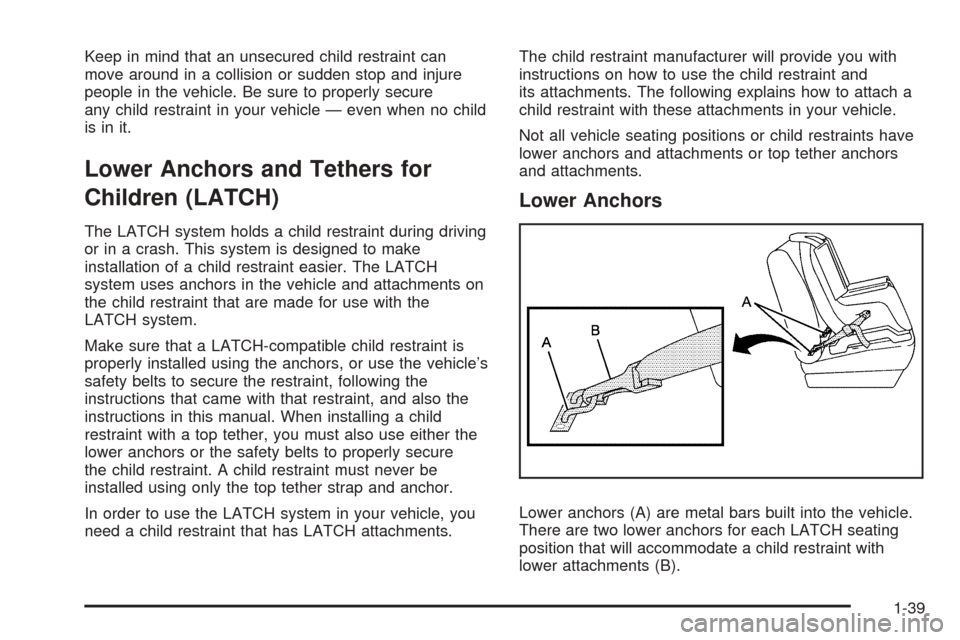
Keep in mind that an unsecured child restraint can
move around in a collision or sudden stop and injure
people in the vehicle. Be sure to properly secure
any child restraint in your vehicle — even when no child
is in it.
Lower Anchors and Tethers for
Children (LATCH)
The LATCH system holds a child restraint during driving
or in a crash. This system is designed to make
installation of a child restraint easier. The LATCH
system uses anchors in the vehicle and attachments on
the child restraint that are made for use with the
LATCH system.
Make sure that a LATCH-compatible child restraint is
properly installed using the anchors, or use the vehicle’s
safety belts to secure the restraint, following the
instructions that came with that restraint, and also the
instructions in this manual. When installing a child
restraint with a top tether, you must also use either the
lower anchors or the safety belts to properly secure
the child restraint. A child restraint must never be
installed using only the top tether strap and anchor.
In order to use the LATCH system in your vehicle, you
need a child restraint that has LATCH attachments.The child restraint manufacturer will provide you with
instructions on how to use the child restraint and
its attachments. The following explains how to attach a
child restraint with these attachments in your vehicle.
Not all vehicle seating positions or child restraints have
lower anchors and attachments or top tether anchors
and attachments.
Lower Anchors
Lower anchors (A) are metal bars built into the vehicle.
There are two lower anchors for each LATCH seating
position that will accommodate a child restraint with
lower attachments (B).
1-39
Page 44 of 414
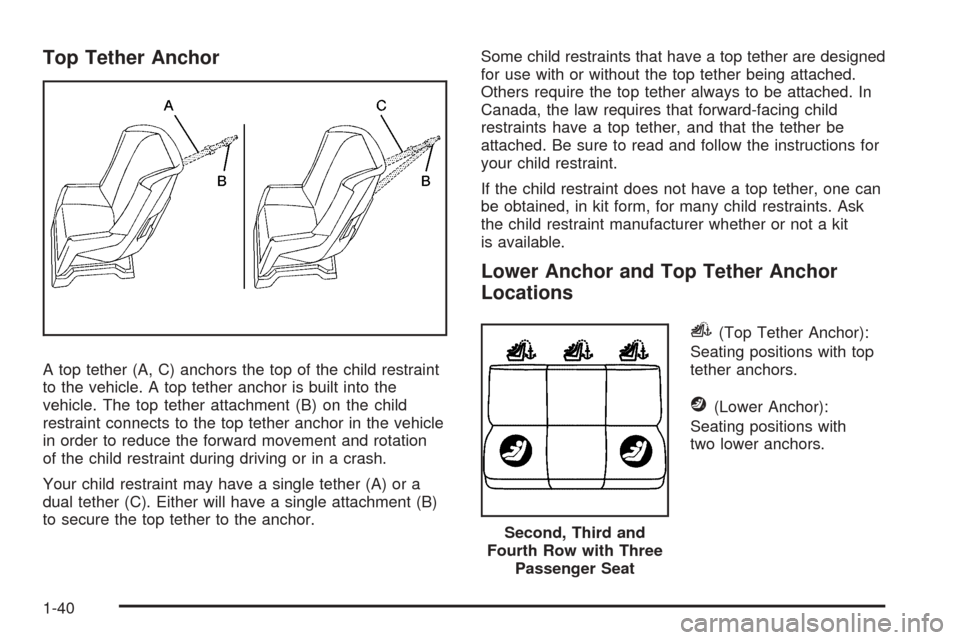
Top Tether Anchor
A top tether (A, C) anchors the top of the child restraint
to the vehicle. A top tether anchor is built into the
vehicle. The top tether attachment (B) on the child
restraint connects to the top tether anchor in the vehicle
in order to reduce the forward movement and rotation
of the child restraint during driving or in a crash.
Your child restraint may have a single tether (A) or a
dual tether (C). Either will have a single attachment (B)
to secure the top tether to the anchor.Some child restraints that have a top tether are designed
for use with or without the top tether being attached.
Others require the top tether always to be attached. In
Canada, the law requires that forward-facing child
restraints have a top tether, and that the tether be
attached. Be sure to read and follow the instructions for
your child restraint.
If the child restraint does not have a top tether, one can
be obtained, in kit form, for many child restraints. Ask
the child restraint manufacturer whether or not a kit
is available.
Lower Anchor and Top Tether Anchor
Locations
i(Top Tether Anchor):
Seating positions with top
tether anchors.
j(Lower Anchor):
Seating positions with
two lower anchors.
Second, Third and
Fourth Row with Three
Passenger Seat
1-40
Page 45 of 414
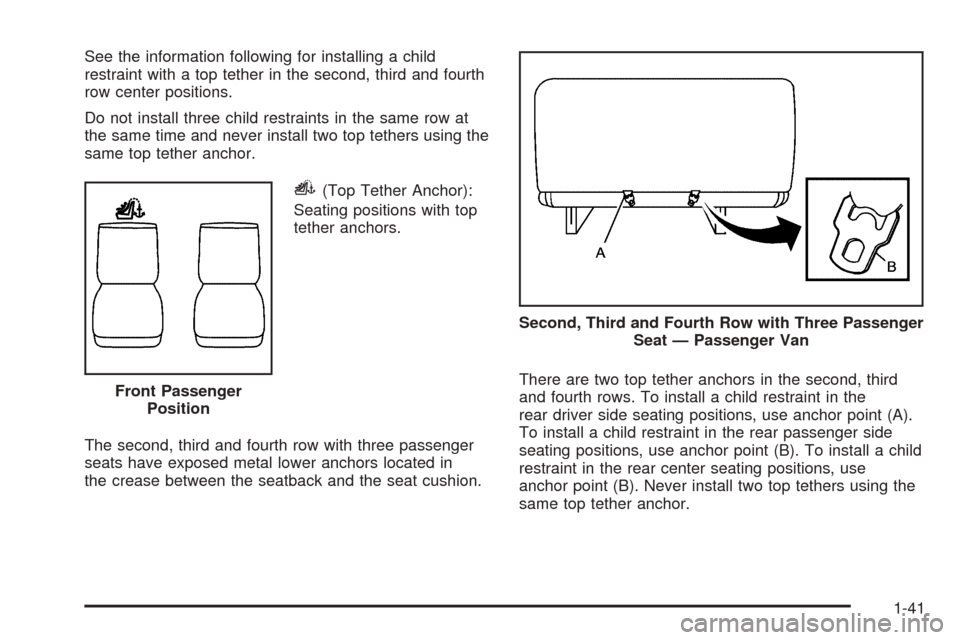
See the information following for installing a child
restraint with a top tether in the second, third and fourth
row center positions.
Do not install three child restraints in the same row at
the same time and never install two top tethers using the
same top tether anchor.
i(Top Tether Anchor):
Seating positions with top
tether anchors.
The second, third and fourth row with three passenger
seats have exposed metal lower anchors located in
the crease between the seatback and the seat cushion.There are two top tether anchors in the second, third
and fourth rows. To install a child restraint in the
rear driver side seating positions, use anchor point (A).
To install a child restraint in the rear passenger side
seating positions, use anchor point (B). To install a child
restraint in the rear center seating positions, use
anchor point (B). Never install two top tethers using the
same top tether anchor. Front Passenger
Position
Second, Third and Fourth Row with Three Passenger
Seat — Passenger Van
1-41
Page 46 of 414
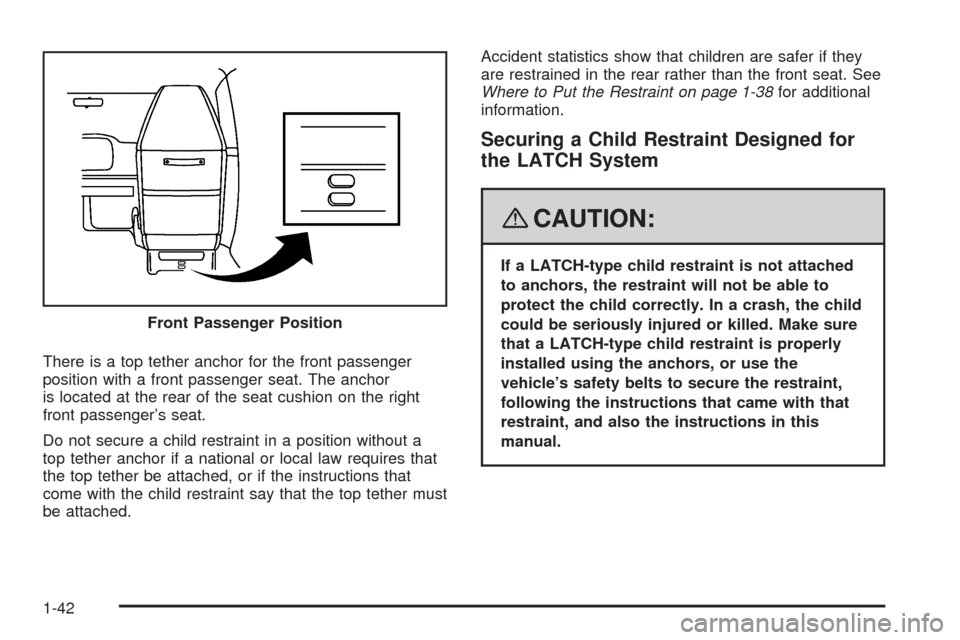
There is a top tether anchor for the front passenger
position with a front passenger seat. The anchor
is located at the rear of the seat cushion on the right
front passenger’s seat.
Do not secure a child restraint in a position without a
top tether anchor if a national or local law requires that
the top tether be attached, or if the instructions that
come with the child restraint say that the top tether must
be attached.Accident statistics show that children are safer if they
are restrained in the rear rather than the front seat. See
Where to Put the Restraint on page 1-38for additional
information.
Securing a Child Restraint Designed for
the LATCH System
{CAUTION:
If a LATCH-type child restraint is not attached
to anchors, the restraint will not be able to
protect the child correctly. In a crash, the child
could be seriously injured or killed. Make sure
that a LATCH-type child restraint is properly
installed using the anchors, or use the
vehicle’s safety belts to secure the restraint,
following the instructions that came with that
restraint, and also the instructions in this
manual. Front Passenger Position
1-42
Page 47 of 414
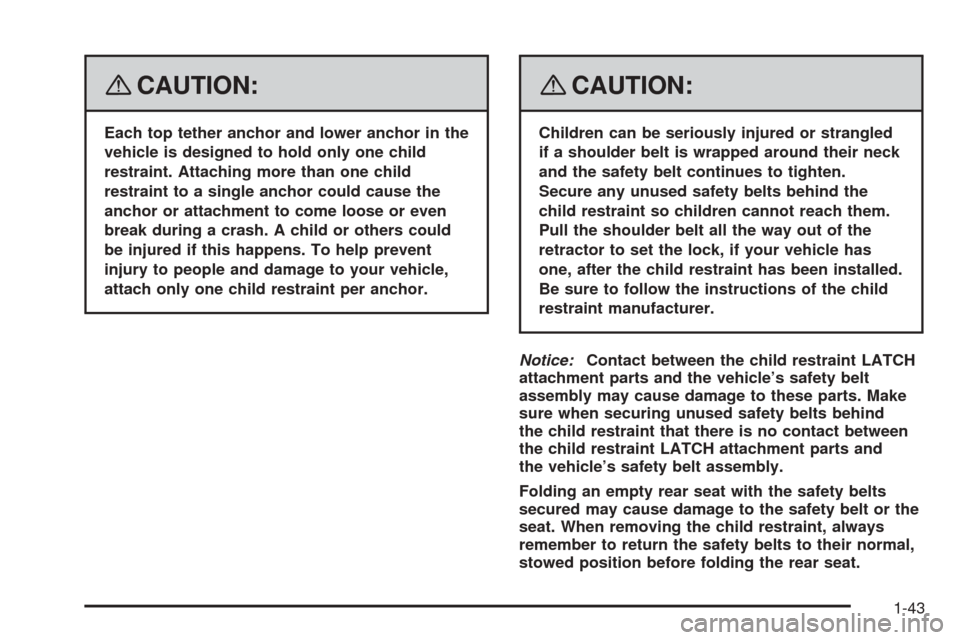
{CAUTION:
Each top tether anchor and lower anchor in the
vehicle is designed to hold only one child
restraint. Attaching more than one child
restraint to a single anchor could cause the
anchor or attachment to come loose or even
break during a crash. A child or others could
be injured if this happens. To help prevent
injury to people and damage to your vehicle,
attach only one child restraint per anchor.
{CAUTION:
Children can be seriously injured or strangled
if a shoulder belt is wrapped around their neck
and the safety belt continues to tighten.
Secure any unused safety belts behind the
child restraint so children cannot reach them.
Pull the shoulder belt all the way out of the
retractor to set the lock, if your vehicle has
one, after the child restraint has been installed.
Be sure to follow the instructions of the child
restraint manufacturer.
Notice:Contact between the child restraint LATCH
attachment parts and the vehicle’s safety belt
assembly may cause damage to these parts. Make
sure when securing unused safety belts behind
the child restraint that there is no contact between
the child restraint LATCH attachment parts and
the vehicle’s safety belt assembly.
Folding an empty rear seat with the safety belts
secured may cause damage to the safety belt or the
seat. When removing the child restraint, always
remember to return the safety belts to their normal,
stowed position before folding the rear seat.
1-43
Page 48 of 414
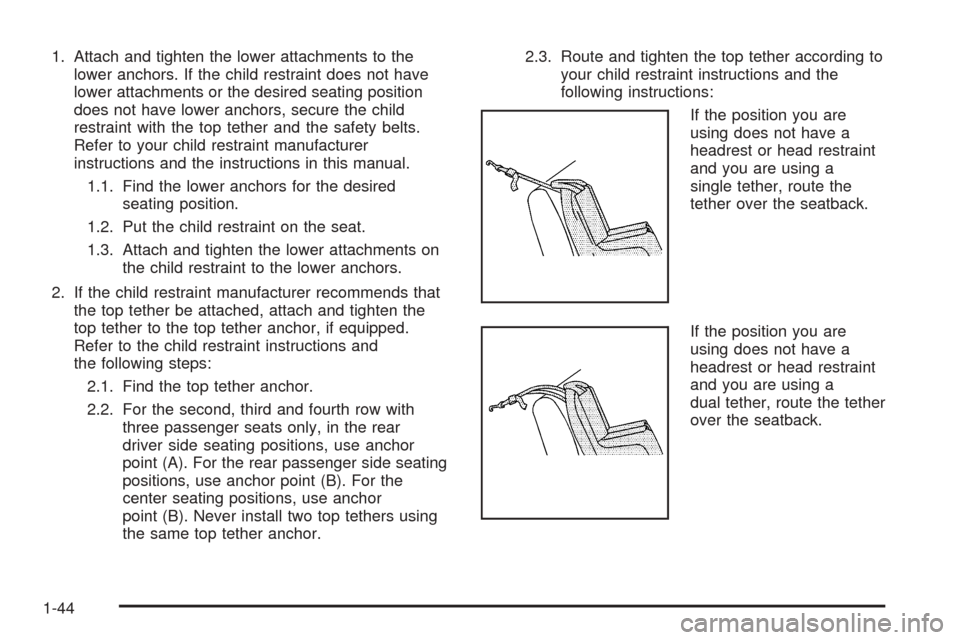
1. Attach and tighten the lower attachments to the
lower anchors. If the child restraint does not have
lower attachments or the desired seating position
does not have lower anchors, secure the child
restraint with the top tether and the safety belts.
Refer to your child restraint manufacturer
instructions and the instructions in this manual.
1.1. Find the lower anchors for the desired
seating position.
1.2. Put the child restraint on the seat.
1.3. Attach and tighten the lower attachments on
the child restraint to the lower anchors.
2. If the child restraint manufacturer recommends that
the top tether be attached, attach and tighten the
top tether to the top tether anchor, if equipped.
Refer to the child restraint instructions and
the following steps:
2.1. Find the top tether anchor.
2.2. For the second, third and fourth row with
three passenger seats only, in the rear
driver side seating positions, use anchor
point (A). For the rear passenger side seating
positions, use anchor point (B). For the
center seating positions, use anchor
point (B). Never install two top tethers using
the same top tether anchor.2.3. Route and tighten the top tether according to
your child restraint instructions and the
following instructions:
If the position you are
using does not have a
headrest or head restraint
and you are using a
single tether, route the
tether over the seatback.
If the position you are
using does not have a
headrest or head restraint
and you are using a
dual tether, route the tether
over the seatback.
1-44
Page 49 of 414
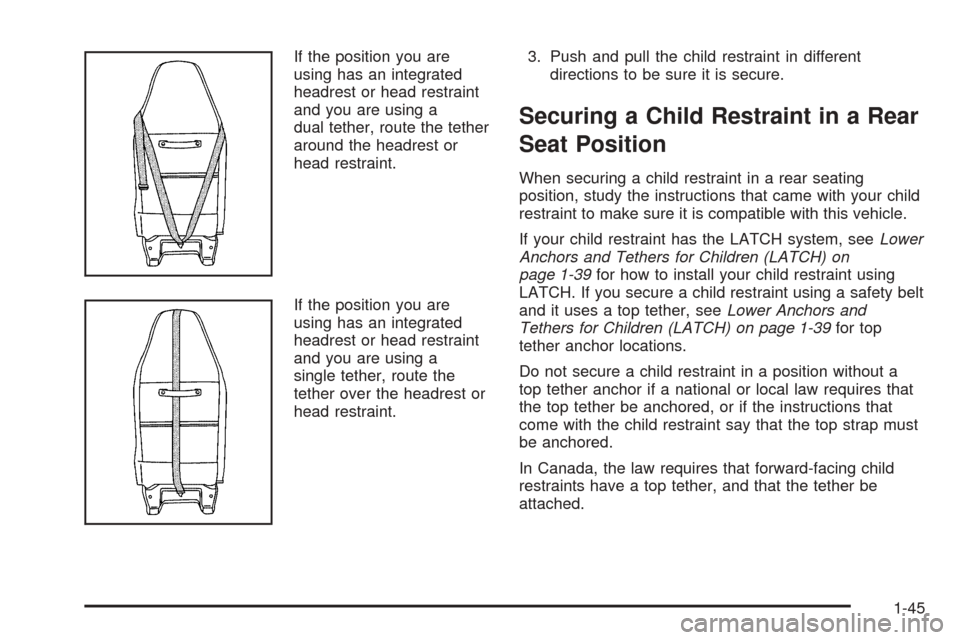
If the position you are
using has an integrated
headrest or head restraint
and you are using a
dual tether, route the tether
around the headrest or
head restraint.
If the position you are
using has an integrated
headrest or head restraint
and you are using a
single tether, route the
tether over the headrest or
head restraint.3. Push and pull the child restraint in different
directions to be sure it is secure.
Securing a Child Restraint in a Rear
Seat Position
When securing a child restraint in a rear seating
position, study the instructions that came with your child
restraint to make sure it is compatible with this vehicle.
If your child restraint has the LATCH system, seeLower
Anchors and Tethers for Children (LATCH) on
page 1-39for how to install your child restraint using
LATCH. If you secure a child restraint using a safety belt
and it uses a top tether, seeLower Anchors and
Tethers for Children (LATCH) on page 1-39for top
tether anchor locations.
Do not secure a child restraint in a position without a
top tether anchor if a national or local law requires that
the top tether be anchored, or if the instructions that
come with the child restraint say that the top strap must
be anchored.
In Canada, the law requires that forward-facing child
restraints have a top tether, and that the tether be
attached.
1-45
Page 50 of 414
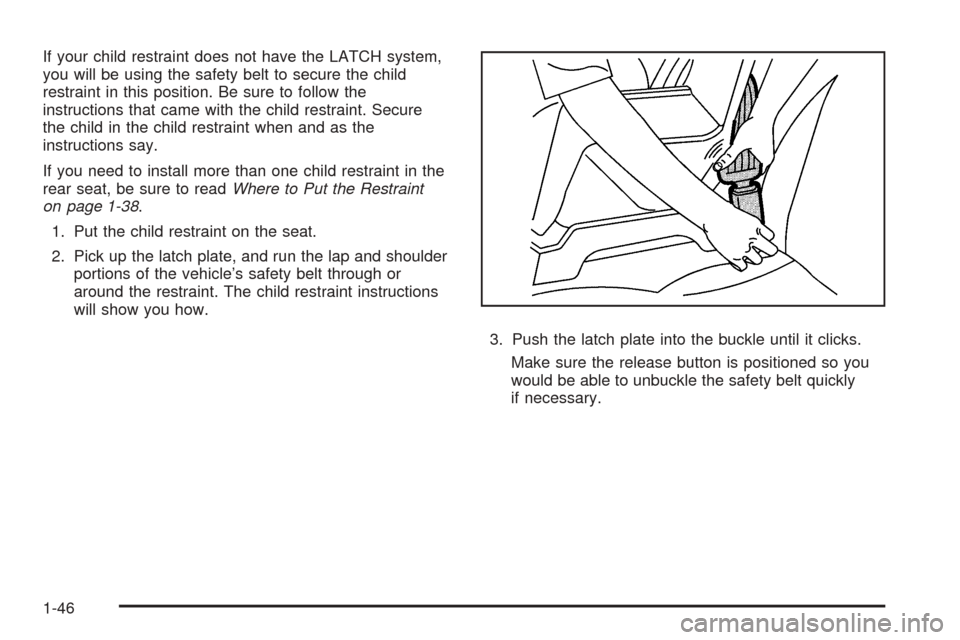
If your child restraint does not have the LATCH system,
you will be using the safety belt to secure the child
restraint in this position. Be sure to follow the
instructions that came with the child restraint. Secure
the child in the child restraint when and as the
instructions say.
If you need to install more than one child restraint in the
rear seat, be sure to readWhere to Put the Restraint
on page 1-38.
1. Put the child restraint on the seat.
2. Pick up the latch plate, and run the lap and shoulder
portions of the vehicle’s safety belt through or
around the restraint. The child restraint instructions
will show you how.
3. Push the latch plate into the buckle until it clicks.
Make sure the release button is positioned so you
would be able to unbuckle the safety belt quickly
if necessary.
1-46